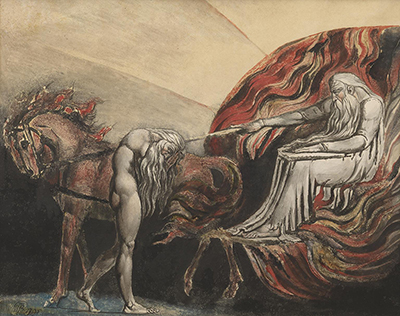God Judging Adam by William Blake is a hand-finished relief etching printed on paper from a copper plate. Blake painted the artwork in 1795, and it has dimensions of 638 x 738 x 48 mm. In the image, there are two images: a nude man and another man sited on a fiery chariot.
The nude man seems to be bowing to the man in the chariot, meaning he is superior. On the other hand, the man on the chariot is fully dressed and has a book on his lap. For many years, viewers of this image thought that the image represented Elijah in the fiery chariot, but it was recently connected to the biblical story of God condemning Adam for tasting the forbidden fruit. Gods figure in the painting resembles Urizen, a tyrannical law-maker from Blake's imagination.
Style used
Blake used a unique method, which he had invented himself, to create the image. He used a plate etched in relief and then painted colours on millboard before printing them on the sheet. One can notice the broken texture along the light grey outline of God’s right arm produced when the printing plate was lifted from the paper. Finally, he enhanced the printed with ink and watercolour.
Who inspired Blake into painting
Since most paintings by Blake are mythological, it is believed that he might have drawn some inspiration from his religious background. Some of his works are also illustrations of his own poems, but they were actual visions to him. Blake started engraving copies of drawings at an early age by the great old masters of the Renaissance, like Michelangelo, Raphael and Albrecht Durer. He also was sent by his family to be appreciated by James Basire, an engraver. The apprenticeship started when he was 14 years and lasted for seven years, after which he joined the Royal Academy of Fine Arts in London. While the apprenticeship and the trainings at the Parr's drawing School and Royal Academy may not have influenced his art style, they all left a mark on the technical part of his work.
Artists inspired by Blake
When it comes to imaginative painting, no other artist can fit in Blake's shoes. His works can only be compared to the sculptors and illuminators of the twelfth century. Though his genius was too strange to have much influence on other painters, Edward Calvert, a wood –engraver, and Samuel Palmer were his followers. He can also be referred as the father of Pre-Raphaelite Brotherhood as he was the first person to deliberately react against Joshua Reynolds's influence.




